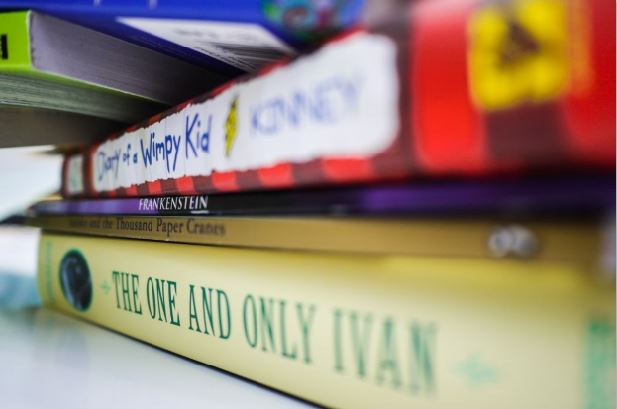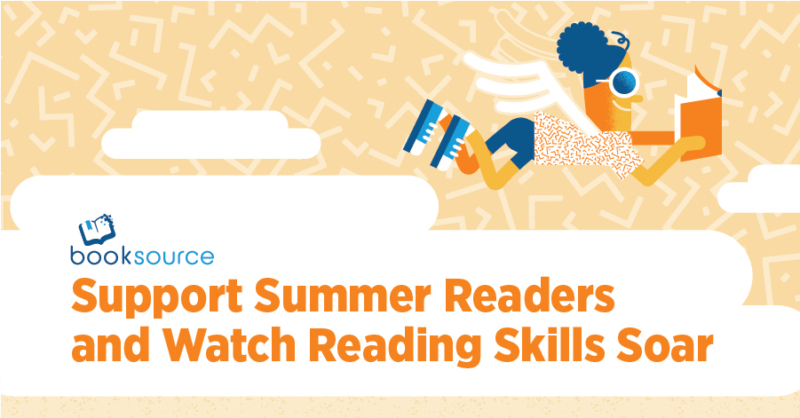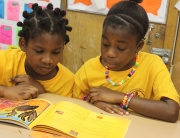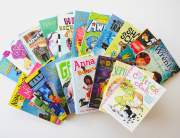By Richard L. Allington, Ph.D., and Anne McGill-Franzen, Ph.D.
According to a recent National Assessment of Educational Progress (NAEP) report, 12th-grade students from low-income families read four years below middle-class 12th-graders. In fact, their reading performance in 12th grade is equal to the performance of middle-class 8th-grade students! In the U.S., as is the case in every other nation, kids from low-income families do not read as well as kids from more affluent families. So the question one has to attempt to answer is this: Why do low-income students lag behind middle/upper-income students in reading development?
Various popular theories abound in attempting to answer this question. For the longest period of time, the parents were thought to be the problem. More recently, it is teachers of low-income children who have been identified as the problem. That is, teachers in high-poverty schools are either not as talented as teachers in suburban schools or teachers in high-poverty schools simply do not work as hard as teachers in suburban schools. This line of hypothesizing has led to schemes whereby all teachers will be paid (or retained in employment) only when their students make good progress with reading development.
The problem with these popular theories is that they have both been proven wrong by the evidence we already have available.
Evidence that, it seems, no one in the U.S. Department of Education is familiar with and evidence that has also escaped being noticed by the folks who run state departments of education. That is, I know of not a single federal—or state—developed plan for addressing the actual problem that underlies the rich/poor reading achievement gap.
The Primary Source of the Rich/Poor Reading Achievement Gap
What has become clear over the past 35 years is that low-income students learn as much during each school year as do middle-class students (Alexander, Entwisle & Olson, 2007: Hayes & Grether, 1983; Heyns, 1978). But every summer, when school is not in session, kids from low-income families lose two or three months of reading growth, and middle-class kids add a month of reading growth. This means that even when schools for kids in both high-income and low-income families are equally effective, summer reading loss widens the reading achievement gap that existed when these children began kindergarten.
Why is there this family economic trigger that creates summer reading loss, and is there a way to neutralize that trigger and end the summer reading loss that kids in low-income families experience? The answers to this two-part question are now reasonably clear. Students from lower-income families experience summer reading loss because they don’t read much, if at all, during the summer months. Students from middle-class families, on the other hand, are far more likely to read during this same summer period. Low-income students don’t read during the summer months because they don’t own any books, and they live in neighborhoods where there are few, if any, places to purchase books. Middle-class students have bedroom libraries and live in neighborhoods where children’s books are readily available, even in the grocery stores where their parents shop. Middle-class kids are more likely to live in a neighborhood where one can find a child-friendly public library than is the case with children living in low-income areas. These children live in neighborhoods best described as book deserts.
Historically, low-income students relied primarily on schools as sources for the books they read. Ironically, too many high-poverty schools have small libraries, and there are too many classrooms that have no classroom library for kids to select books to read. Too many high-poverty schools ban library books (and textbooks) from leaving the building (fear of loss of the books, I’m usually told). However, even with fewer books in their schools and more restrictive book-lending policies, these kids do get most of the books they read from the schools they attend. But not during the summer months when school is not in session!
Even when there is a summer school program operating, the school library typically remains closed. So the question we must ask is this: Where are children from low-income families supposed to get books to read during the summer months?
We organized spring book fairs in 17 high-poverty elementary schools (between 400 and 600 book titles were available at each book fair) and randomly selected roughly 1,000 students to self-select the 15 books they would be given on the last day of school, just as summer vacation began. We also selected a similar number of children to serve as control students. These kids did not get any books on the final day of the school year. The children were completing either 1st or 2nd grade when we began the study, which then ran for three consecutive years.
When the study began, the two groups were at similar levels of reading development. But after three consecutive summers of easy access to self-selected books, the kids with access to books read significantly better than the control (no books) kids. The difference between the two groups’ reading development was roughly a half-year. In other words, providing poorer students with easy access to books literally ameliorated summer reading loss! As fulfilling as this result was, we found it even more fulfilling that the achievement growth of the poorest students (those eligible for free lunches) was twice as large as the general effect. This effect and the effects others have reported indicate that it is primarily the children from low-income families who benefit from summer book distributions (Allington, McGill-Franzen, Camilli, Williams, Graff, Zeig, Zmach & Nowak, 2010; Kim & Quinn, 2013; White, Kim, Kingston & Foster, 2014).

It is also important to note that the gains in our summer book distribution study were as large as the typical gains generated by attending summer school (Cooper, et al, 1996). Of course, our project cost much less than summer school attendance. Roughly $50 per child, per summer, is what it cost to run the book fairs and summer book distribution. It is also important to note that we did not require students to write book reports or take quizzes on the books they selected. All we really did was create a process such that children in low-income families were given easy access to books they wanted to read during the summer vacation period.
Finally, I’ll close this short summary by noting that our study differed from virtually every other study of summer book distribution in two ways. First, the children in our study were younger than the students others have used (often it seems as though students in grades 4, 5 and 6 have been the kids getting summer books, not in grades 1, 2, 3 and 4, as was the case in our study). Second, we have been the only summer books study that allowed our participants to self-select the books they would receive (other studies have simply distributed the same sets of books to all students or tried matching kids using their reading levels and responses on an interest inventory). We think both of these factors, unique to our study, are the reasons we found that distributing summer books solved the problem of summer reading loss (Allington & McGill-Franzen, 2013).
In our view, the summer reading loss and the widening rich/poor reading achievement gap are both solvable problems. But few schools seem to have implemented any strategy to attempt to equalize children’s access to books during the summer months. It is not the case that our books distribution effort was so expensive that schools simply cannot afford it. I’m not sure why, after 35 years, summer reading loss and book access remain serious problems for children from low-income families. Likewise I’m not sure why it is that virtually no action to address this problem has been taken at the federal, state or local school district level.
What I am sure of is that it is patently unfair to blame kids or their parents or their teachers for the rich/poor reading achievement gap.
References
Alexander, K. L., Entwisle, D. R., & Olson, L. S. (2007). Lasting consequences of the summer learning gap. American Sociological Review, 72(2), 167-180.
Allington, R. L., & McGill-Franzen, A. (2013). Summer reading: Closing the rich/poor reading achievement gap. New York: Teachers College Press.
Allington, R. L., McGill-Franzen, A. M., Camilli, G., Williams, L., Graff, J., Zeig, J., et al. (2010). Addressing summer reading setback among economically disadvantaged elementary students. Reading Psychology, 31(5), 411-427.
Cooper, H., Nye, B., Charlton, K., Lindsay, J., & Greathouse, S. (1996). The effects of summer vacation on achievement test scores: A narrative and meta-analytic review. Review of Educational Research, 66(3), 227-268.
Hayes, D. P., & Grether, J. (1983). The school year and vacations: When do students learn? Cornell Journal of Social Relations, 17(1), 56-71.
Heyns, B. (1978). Summer learning and the effects of schooling. New York: Academic Press.
Kim, J. S., & Quinn, D. M. (2013). The effects of summer reading on low-income children’s literacy achievement from kindergarten to grade 8: A meta-analysis of classroom and home interventions. Review of Educational Research, 83(3), 386-431.
White, T. G., Kim, J. S., Kingston, H. C., & Foster, L. (2014). Replicating the effects of a teacher-scaffolded voluntary summer reading program: The role of poverty. Reading Research Quarterly, 49(1), 5-30.
Watch the replay of our Summer Reading Webinar, “Support Summer Readers and Watch Reading Skills Soar,” to learn practical strategies for promoting summer reading, discover resources for developing a school-wide summer reading solution and access free summer reading printables you can share with parents and guardians at home.











I am highly offended by the comments in this article! I would challenge this man who wrote this article to come to my elementary school and show me just exactly what he means by untalented and lazy teachers! Anyone who has ever taught in a Title 1 school knows that we are very talented and highly motivated to reach these children. It is in fact a lot easier to teach in “average” schools but we choose to teach in our school because we feel we cAn an we do make a difference ! So why don’t you find someone else to talk down too other than those of us who invest ourselves in the lives of these children who not just anyone can teach!
Jan Lowery, you must have read a completely different article. The author points to LACK OF ACCESS TO BOOKS as the primary contributor to reading lags among poor children. He mentions that OTHER people have suggested less qualified teachers are the source of the discrepancy and goes on to disagree with this notion. Please read it again and reconsider your comments.
The authors raise that theory to discredit it. If you read just a little further it is obvious that they do not agree with it.
Thank you for your comment. We think Dr. Richard Allington would agree with you about the challenges that teachers face when teaching at low-income schools. He begins by presenting popular theories of the problem (one being about the talents of the teachers), but then goes on to say, “The problem with these popular theories is that they have both been proven wrong by the evidence we already have available.” We hope this provides some clarity, and we thank you for your dedication to teaching.
Why spend more money on distributing books instead of just encouraging them to use the public library? They have no problem walking to the city pool that is located two blocks from the library. I don’t think most schools should be faulted for not spending money on something the city is already paying for with taxpayer money.
As the article points out, there may be fewer public libraries in he exact areas where they might be the most needed.
Could not be much poorer than my family when we were growing up, but I managed to check a book out of the school library and read it on the 18 mile bus ride to and from school, turn it in and get another book to read.
I would lay the problem on those who are in poverty and have no desire to raise themselves up.
agree…
Most schools don’t let kids take books home during the summer. THAT was the whole point of the article. You might consider reading it again.
So I say to B. Tullos I know not one parent who is letting their 1st, 2nd, 3rd, 4th, 5th or even 6th grader on a public bus alone to go to even the library in my area of San Jose CA. Some of the lower income families I know of the parent or parents work 2 & 3 jobs. So while it’s easy to say “I went to the library” problem solved, tax payers already pay for the public library. Thankfully in our area some libraries have started to stay open later up until 9pm, but parents still come home tired and don’t take their kids.
Not every child lives within walking distance of a public library. My rural district covers over 435 square miles in east Texas. Many students literally live “back in the woods” and are unable to get to the town library 25+ miles away. We’ve given quality picture books to lower income children in the past, only to see them being sold in yard sales the next week after school is out. I questioned one young mother on why she was selling her chidren’s brand new books and she responded, “Them’s just for babies. My kids is gonna be in Kindergarten!” Owl Moon, Chrysanthemum, and 100 Hungry Ants are “baby books?” Sheesh!
I know there is not a one-size-fits-all answer to this problem, but I think this article reinforces the importance of self-selection and the lack of an assignment being tied to gift books as great incentives to get children reading over summer break.
I found the article insightful. My take on the author’s finding is to provide access to reading materials for children. Those children who are self motivated can benefit greatly. It won’t hurt to provide easier access to reading materials to our children.
I grew up poor, but I remember my grandma telling me, “There is no shame in being poor, but there is NO excuse for being dirty or stupid. Soap is cheap & libraries are free.”
After 30 years in the classroom, I believe that the value a family places on education is one of the most important factors that influences reading/academic achievement. Students in low income families don’t have the background experiences that middle class or affluent students seem to have, for whatever reason. With education comes higher paying jobs. If you go to school and get a good education, you can make money. In my experience, poor families don’t place the same value on education as middle and upper class families. Of course, I believe there is always a way around life situations that you don’t like; it takes strong work ethic and good morals and values instilled at a very young age. I think it is ridiculous to say that low-performing students make poor progress due to lack of teacher dedication. At the very least, if I can’t get a child to school, how can I teach him?
Omg I didn’t know that and it was so good to read and I didnt know that was true and I am going to read this summer and going to read at the public Libray
I think this is a very thoughtful take on a very real problem. Others have commented why not just go to a library. Our students don’t have access to regular transportation, plus there may be some worries about the ID needed to sign up at the library. I am doing a bookmobile-type program with my students this summer and am very excited about being able to get books in their hands over their vacation!
I enjoyed reading this research and believe it is true. I like that the cost is low and results are high. I’m wondering what would happen if EVERY child received books they chose to read over the summer? Would the gap remain the same with everyone gaining? I have always thought that putting children’s books at the local food bank, that they could select each time they went with their parents, is another way to get books into student’s hands… The motto above the book shelf could read, “Feed the body, Feed the mind.”
All of this great research was conducted by experts in the field who have dedicated their lives to understanding literacy acquisition, yet people continue to insist on the simplistic explanation that poor students from families with little to no formal education don’t read well because they are lazy and do not value education. It is mind-boggling.
[…] Why Do Poor Students Lag Behind Rich Students in Reading Development? […]
Low income parents don’t buy books for their children because they feel it isn’t important. I was once a low income parent and I always purchase books for my child. I always took trips to the library. Low income single mother rather get their nails done and buy expensive Brazilian weaves than buy a book for their children. Low income single mother will pay $200 on Air Jordans so their child can look fresh for school but wont purchase a book. Low income single mothers in the ghetto don’t care about education. If you notice most crime and underfunded school are in low income single parent neighboorhoods
I agree with you ?. I am a teacher and encourage reading and try to bring the joy of books into students lives. Fortunately, I am able to reach many students with the love of literacy by selecting books of high interest. Their parents, while poor, instill in them the importance and necessity of education. However, there are FAR too many students whose parents buy them fancy Jordan’s, iPhones or video games, and couldn’t care less about their grades, whether they read at home or how much time they spend on social media sites. I don’t know how this can change-but too many students are being brought up in these types of homes. They have money/access to what they want rather than need. Anyway, just my two cents! Have a great day!
I teach in a district with high poverty rates and I also live in a high poverty area I totally agree with the article that’s why I personally give all of my students books to read over the summer. I also help to support several free little libraries in our surrounding communities so that all children have easy access to books.
All children need access to books. Putting gently used titles, or even retired textbooks in apartment complex or trailer park offices to be read there or “borrowed” increases access. Books will disappear, but many children will pick them up. These “picture books” should be many of the same titles that teachers have previously read to them. Many children will pick familiar titles, or colorful pictures, or simply become the “teacher” to anyone, or anything around. An interest in literacy can be enhanced through access.
Many schools used to have summer reading lists … few do today.
But it is not just about the access to books … if a child does not have the “example” to follow, he/she will just be bringing the books home and not doing a bit of reading. Also, many of the kids from these neighborhoods do not have a parent home during the day, and the parent/responsible adult may not be there at night either.
I work in a low income school and I completely agree with this article. I sent some books home with my students this year. I have tried for the last several years to come up with a solution that doesn’t not cost anything, but no one at my school has been very receptive. It is amazing to think that this problem could be virtually alleviated with just $50.00 a student. I just have to find a grant to help and we will be set for next year.
Thanks for sharing your experiences, Cathy—and good luck finding a grant next year so you can send books home with your students! – The Booksource Team
I’m not sure how I feel about this article. I think it is more complicated than this article makes it seem. Our school (and in fact, every elementary school in our district) chooses low income students to choose 10 self selected books to keep at the end of each school year. So families with multiple students could have 20,30 or more new books each year to build a home library. Many of the same students have been participating over several years which would continue build their home libraries. We can not say that we have seen the same consistent results. We believe it helps, but have yet to prove consistently that this is making a measurable difference based on reading scores. Not that we won’t continue or thatbit is not valuable, but this article makes it seem like it is a magic bullet and it is not. Be careful over generalizing.
I am appalled that the authors ignore the value of school librarians. Classroom collections are not libraries. A school librarian guides students from their pre-reading throughout a school experience and fosters independent reading as children are known and nourished with a curated collection. School librarians connect students to public library programs which complement school library programs. This article is very flawed.
As a second grade teacher for 25 years in a Title 1 school, I used my points from the Scholastic Book orders to obtain many, many age-appropriate books for my students. Over the course of a school year, each of my students received at least 6 books, 2 for their birthday, 2 at Christmas, and 2 for the summer. I also would give out books as prizes for various reasons. I always wrote an inscription in the front cover so they would remember where the book came from. Years later many students returned an told me that they still had the books that I gave them. I also got books from library sales where I could get a large grocery bag of books for 5 dollars. I found this article to be very valid because the books that I gave my students were often the only books in their homes. I also believe that owning a book make the book more important.
I’m offended because the author states that the middle class has a bedroom library which isn’t true. The middle class families may be more willing to take their children to local libraries and encourage their children to read the books that are provided by the government for free. My husband grew up in a low SES home and his parents took him to the library. It’s about attititude and fortitude that makes a difference in reading achievement.
Cathy Perty (others)
Where are you located? I am in Rochester, NY and would love to work with someone to get a grant for children’s books next summer or sooner.
Jane
As a teacher I find this research very interesting and would have to agree. My career has been spent in Title I schools. I have encouraged my parents to get Library cards for their children but several parents told me that they did not want to get their child a Library card because they could not afford the Library fines when the books were not returned in time. There are times everywhere that are disorganized and books get lost…again, this also stems from the lack of value on education…I would love to get a grant to provide books for kids!
I offer a unique perspective because I teach.in an economically diverse school where middle class and poor (and even some upper middle class) students are mixed. Our district’s population is low, so students are bused from everywhere: subdivisions, the “back woods,” and the local towns. Without a doubt, the middle class students have higher achievement and work ethic. Parents will drive 40 minutes from the suburbs to visit the library or enroll their children in summer reading programs, but the low income families who live in town walking distance from the library usually do not show up. I see them playing at the parks or in the grocery stores, but not at the summer programs or libraries. I have children of my own, so can verify this from personal experience.
When I invite my students to these programs when I see them out and about I hear, “we ain’t got time for that” from parents. Some of the disadvantaged families rise up and try to overcome, but only a minority. Also, when I send summer “homework” packets home (usually reading logs, books, and math sheets), I usually only get them returned the following year from the middle class students. I absolutely think it’s a problem that starts from home, not the schools or from the communities.
To ebony: I have taught in a low income (Title 1) school for 15 years. I have come across parents that don’t value education and many that do. You cannot make a blanket statement about parents in poverty not caring about education. You said you were low income and still bought books for your children. You didn’t fit the “mold” your claiming is happening within low income families. The best presentation I saw was by the author Ruby Payne. She explained the mindset of those in poverty. If you get a chance, please see her speak on YouTube or read one of her books. You’ll see why they buy Jordans and get their hair and nails done. I’m not saying I agree with the choices the parents are making, but I understand it. Once you understand the problem, you can try to fix it. It is extremely frustrating when I work hard as a teacher and get no support from the parents/grandparents/guardians. However, I communicate more with those parents to show them how valuable education is. Hopefully after hearing Ruby Payne, your perspective will change and you can challenge yourself to make a difference instead of complaining about it. If we are to change the mentality it will take time. However, sending books home for them to read is a simple, low cost solution. It won’t”fix” the problem with the poverty mindset, but it’s a start.
I agree with much of this article, however, there is another issue (which is not addressed in the above article) which contributes significantly to the difficulty of learning to read. The high trauma that these students of poverty experience is a time robber. My classroom had foster kids, kids who lived in buildings where teens ran around robbing each other with pistols, single parents that left the kids home alone while they worked late shifts, working two and three different jobs. These children frequently had fist fights and used profane language with each other, boys and girls. I spent a lot of my time teaching SEL (social emotional learning). Teaching social skills, and social problem solving. A lot of class time (which is spent teaching/learning in non-poverty classrooms) is devoted to helping students deal with their trauma, so they could finally be in a place where they could process the lessons. The more trauma, the less time to learn. Here is an article that will clarify what I am describing.
http://bit.ly/2r2p9N2
I agree with much of this article, however, there is another issue (which is not addressed in the above article) which contributes significantly to the difficulty of learning to read. The high trauma that these students of poverty experience is a time robber. My classroom had foster kids, kids who lived in buildings where teens ran around robbing each other with pistols, single parents that left the kids home alone while they worked late shifts, working two and three different jobs. These children frequently had fist fights and used profane language with each other, boys and girls. I spent a lot of my time teaching SEL (social emotional learning). Teaching social skills, and social problem solving. A lot of class time (which is spent teaching/learning in non-poverty classrooms) is devoted to helping students deal with their trauma, so they could finally be in a place where they could process the lessons. The more trauma, the less time to learn. Here is an article that will clarify what I am describing.
http://bit.ly/2r6DMyQ
Books alone are not going to do it. Parents need to be involved and read to/with their children. If parents don’t read, chances are their children won’t read either. The children may take books home and stash them somewhere and not touch them all summer if parents don’t get involve and read. TV and video games are one of the main reasons children AND young parents don’t read. These electronic devices are a great escape from reality for low income families. Low income parents need to be given the tools/training to help and motivate their children to read every day.
Sorry, I have no idea what this phrase means: “the achievement growth of the poorest students (those eligible for free lunches) was twice as large as the general effect”
I co-founded Spread the Word Nevada 16 years ago, a non-profit in Las Vegas, Nevada that does just what this article is verifying is needed: giving books to low-income children (year-round and in summer months), offers family literacy programs,and brings volunteers into the schools to work with struggling readers one-on-one. All programs focus on elementary age kids, especially 3rd grade and below, and our book offerings are chosen by the children. It’s the most rewarding work I’ve done and the results of our efforts are making huge changes for our kids in Southern Nevada. Our hope is to help other communities start their own program based on our best practices. It’s a low-cost high-impact program that is making a huge difference for kids.
If low income parents are working then their children would be in highly subsided (or free) summer child care/camp. These programs generally are required to have classroom libraries and to set aside time daily for reading. If parents are not working, then there is not excuse for not taking the children to the library a few times, even if it isn’t in the immediate neighborhood. I’m not buying lack of access as the primary cause.
Libraries have book mobiles … why don’t schools have book mobiles that travel around during the summer months? So many schools will CUT a librarian position before they ever cut the top-heavy administrative positions … here is an opportunity to do the right thing and keep the librarian.
However, it IS partially the parents “fault” in some of these instances … if the students do not SEE their parents reading, whether it be during the school year or the summer months, it is not very likely the kids are going to be “inspired” to read.
[…] recently came across an article about the inequality of the availability of books between poorer schools and schools in more […]
There may be a little bit of truth in all the statements of how to increase the reading skills for kids from low-economic background. Of course every family is different. But when a study has been made like this that shows summer reading is imperative–let’s check it out in our schools before passing judgment…Schools are given money to improve literacy! Many times it is spent on new programs, books and material for the classroom, paying for substitutes to come in to an unknown classroom so the homeroom teacher can go to yet another “training” session in the “new program”. Let’s just spend some money on leveled books that can be chosen by the students, and taken home for the summers. As a first grade teacher, I do and say everything I can to encourage at home reading, parent/sibling-reading with them, and I send home “my” books with them every night that they return. Plus I tell them how important it is to keep reading all summer, if they want to stay on that level they’ve achieved, and even get better for 2nd grade!! Most are proud of their own achievements, and having books for summer reading available along with their own initiative to read can be powerful.
[…] The Reading Achievement Gap: Why Do Poor Students Lag Behind Rich Students in Reading Development? […]
[…] As the end of the school year approaches, teachers everywhere are thinking about how to encourage their students to continue reading over the summer months to prevent the dreaded “summer slide.” After considering this conundrum myself, I realized that the biggest obstacle my students have over the summer is access to books. […]
[…] do not read as often when they are not at school, especially during the summer. And according to booksourcebanter.com, when school is not in session, children in low-income areas actually lose two to three months of […]